Change Page: < 1234567 > | Showing page 2 of 7, messages 21 to 40 of 131 - powered by ASPPlayground.NET Forum Trial Version
Author
|
Message

|
 Re:Incubating Centropyge eggs and prolarvae.
Saturday, April 23, 2011 7:59 PM
Re:Incubating Centropyge eggs and prolarvae.
Saturday, April 23, 2011 7:59 PM
( permalink)
Kate: Do you rinse the eggs/equipment in water after you peroxide? I do my peroxide dip in a small sieve and then rinse the eggs into another container. I guess my worry would be that you might have residual peroxide in there with the prolarvae. Nice photos, Luis. I'm surprised there's so little yolk left and the mouth still hasn't developed. They are going to need to eat immediately, yeah?
--Andy, the bucket man. "Not to know the mandolin is to argue oneself unknown...." --Clara Lanza, 1886
|
|
|
 Re:Incubating Centropyge eggs and prolarvae.
Sunday, April 24, 2011 5:55 PM
Re:Incubating Centropyge eggs and prolarvae.
Sunday, April 24, 2011 5:55 PM
( permalink)
On the 3rd day,they lay on the bottom dying.I will play some more variations,but I suspect that this method,stagnant water in a 2 L tray,is not working  .Some kind of more elaborated technique,that affords water exchange without surface movement must be used.See that the same problem was found by the yellow tang larval raisers. This pic shows late prolarvae at noon of day 3.There are two constant black marks,one between the oil globule and the cloaca,and the other more distally in the dorsal fin fold.Some smaller pigmented marks show also on the yolk sac and head. 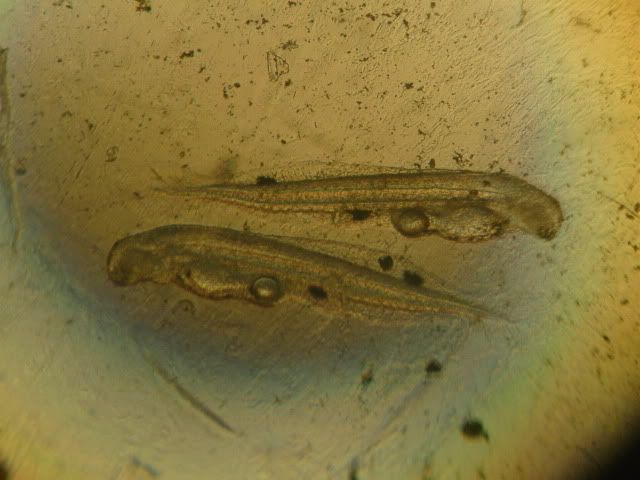
|
|
|
 Re:Incubating Centropyge eggs and prolarvae.
Sunday, April 24, 2011 6:09 PM
Re:Incubating Centropyge eggs and prolarvae.
Sunday, April 24, 2011 6:09 PM
( permalink)
Hmm... Witt was telling me about an interesting concept he came up with a while ago that might work for this. I'll see if I can get him to comment.
|
|
|
 Re:Incubating Centropyge eggs and prolarvae.
Sunday, April 24, 2011 6:14 PM
Re:Incubating Centropyge eggs and prolarvae.
Sunday, April 24, 2011 6:14 PM
( permalink)
Would it be possible to use 1 micron cloth glued into the bottom of the tray with a void underneath it that could be pressurised to have a gentle upwelling across the whole bottom surface? Mabey use a small powerhead to do this? I dont think the water volume across the whole bottom surface would be too great and could possibly suspend the fry just above the bottom. Similar to those table games where the puck is held off the table with a air pressurised bed.
|
|
|
 Re:Incubating Centropyge eggs and prolarvae.
Sunday, April 24, 2011 6:21 PM
Re:Incubating Centropyge eggs and prolarvae.
Sunday, April 24, 2011 6:21 PM
( permalink)
Come to think of it 1 mibron bit too small...Hahah. But you get my drift.
|
|
|
 Re:Incubating Centropyge eggs and prolarvae.
Monday, April 25, 2011 11:52 AM
Re:Incubating Centropyge eggs and prolarvae.
Monday, April 25, 2011 11:52 AM
( permalink)
Tal, Certainly,Witt´s contribution would help here.I still like my tray method,where eggs can be assesed for development easily,and prolarvae progress until day 2. After that the quality of the 2L of water deteriorates and prolarvae die,only few making it up to the 3rd day.One day more and they would be feeding larvae... Duck, Yes,up/downweller could give both water exchange and a quiet surface.I think Andy mentioned something along this line.
|
|
|
 Re:Incubating Centropyge eggs and prolarvae.
Monday, April 25, 2011 1:09 PM
Re:Incubating Centropyge eggs and prolarvae.
Monday, April 25, 2011 1:09 PM
( permalink)
 Originally Posted by I still like my tray method,where eggs can be assesed for development easily,and prolarvae progress until day 2. After that the quality of the 2L of water deteriorates and prolarvae die,only few making it up to the 3rd day.One day more and they would be feeding larvae... That is exactly my experience. The remains of the eggs and the eggs that don't hatch fuel some really ugly water quality. I think it's plausible that bacterial population growth combined with a lack of much oxygen exchange at the water's surface causes O2 levers to drop like a rock.
--Andy, the bucket man. "Not to know the mandolin is to argue oneself unknown...." --Clara Lanza, 1886
|
|
|
 Re:Incubating Centropyge eggs and prolarvae.
Monday, April 25, 2011 11:26 PM
Re:Incubating Centropyge eggs and prolarvae.
Monday, April 25, 2011 11:26 PM
( permalink)
Hi, I rinsed the eggs in the coffee filter by dipping the entire thing in a bath of peroxide which had been warmed by being in the incubator, then yes did rinse in another dish of the incubator water, when it worked best. Figured the peroxide was probably bad for them, and did also worry that my rinse would not be enough but they did hatch and live 24 hours at least afterwards. Really need to set this whole thing up and try again. They are spawning regularly now. It's fun to watch, and frustrating to try to take pictures of. Might have to draw out what I see as the pics are all grainy at the ISO I need to get them. They are so hyper! I have this old aquaculture book describing raising pelagic tuna and it says the eggs will only float if the specific gravity of the water is higher than that of the egg, and the eggs should not sit on the bottom... so how high a salinity do angelfish people use? My reef tank is usually 1.0265 so thought that was plenty high but they tend to sink or at most sit midway up the water column. It describes puffer culture-the larvae are kept in still water for the first week. "It is necessary to change the water daily at first, and up to eight times a day by the end of the week." Ouch. The food was first nauplius stage barnacles, which were cultured by sinking sticks near the surface in spring and fall in the sea, these are stored in tanks later. Exposure to air (does not say how long) followed by placing the sticks in with the larvae resulted in discharge of nauplii within 10 to 20 minutes. Pretty clever. We probably have better first foods these days though. Think I will try resting the coffee filters of eggs on an eggcrate shelf and using a powerhead to keep the water moving, should provide more stable water quality. Wonder if it is worth using a UV unit til they are feeding to keep ciliates under control? Do you guys have any pics or diagrams of downwellers? I see one in this book, it looks like a sump, being a long tank with baffles, and baskets of larvae are placed between the baffles, a pump takes water out at one end and dumps it in the other. Should be simple to make. Probably would not even have to be very big. But I probably would not be able to see the larvae. Kate
|
|
|
 Re:Incubating Centropyge eggs and prolarvae.
Tuesday, April 26, 2011 9:22 AM
Re:Incubating Centropyge eggs and prolarvae.
Tuesday, April 26, 2011 9:22 AM
( permalink)
A downweller is just a tube with mesh at the bottom. They are designed so that you can return water to the top and have it exit at the bottom, but I'm hoping that just passive water exchange is enough to get the larvae through. They really want still water. If that doesn't work, I think I would try a peristaltic pump with a tube running down to just over the mesh at the bottom (i.e., just hardly any flow at all).
--Andy, the bucket man. "Not to know the mandolin is to argue oneself unknown...." --Clara Lanza, 1886
|
|
|
 Re:Incubating Centropyge eggs and prolarvae.
Tuesday, April 26, 2011 11:43 AM
Re:Incubating Centropyge eggs and prolarvae.
Tuesday, April 26, 2011 11:43 AM
( permalink)
I use 1.025,(well 1.023 right now)wanting to enhance egg buoyancy.I guess they´d float allright at 1.020 too. My next move will be to try and move late eggs/early prolarvae into a tray with clean water...
|
|
|
 Re:Incubating Centropyge eggs and prolarvae.
Tuesday, April 26, 2011 7:35 PM
Re:Incubating Centropyge eggs and prolarvae.
Tuesday, April 26, 2011 7:35 PM
( permalink)
I found a prolarva at day 3,PM,still alive amidst a ciliates soup. 2.5 TL,looking about the same as day 3,AM: 
|
|
|
 Re:Incubating Centropyge eggs and prolarvae.
Saturday, April 30, 2011 12:46 PM
Re:Incubating Centropyge eggs and prolarvae.
Saturday, April 30, 2011 12:46 PM
( permalink)
Frustrating and at the same time intriguing  The prolarva die in the 2nd day,no matter what I do.System water,new water.With or without chlorine and/or antibiotics.Went to the extremes of moving every prolarva to a clean tray,with no improvement.I t must be a curse 
|
|
|
 Re:Incubating Centropyge eggs and prolarvae.
Wednesday, May 4, 2011 12:00 PM
Re:Incubating Centropyge eggs and prolarvae.
Wednesday, May 4, 2011 12:00 PM
( permalink)
 I was running short of ideas,with the prolarvae dying in the 2nd day,no matter what. Then I decided to give the eggs a formalin pre-incubation treatment (see posts above by Andy and Kate,regarding H2O2). It definitely improved things!.Eggs seem to develop faster and most important,survival was improved,both in the original tray,as in the clean tray where I had moved some prolarvae in.In this last,there were some alive by 4th day:  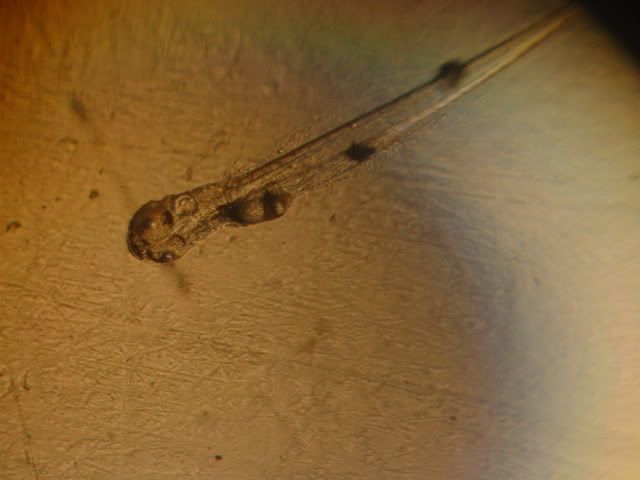 Prolarvae are now 2.6 mm TL.Yolk sac very reduced with oil globule still present.Eyes are more developed,with some incipient pigmentation.The mouth is visible though small.Heart activity started.I think I could see a bud of pectoral fin,must be confirmed.
|
|
|
 Re:Incubating Centropyge eggs and prolarvae.
Wednesday, May 4, 2011 3:03 PM
Re:Incubating Centropyge eggs and prolarvae.
Wednesday, May 4, 2011 3:03 PM
( permalink)
I think it helps to get the bacterial coating off the eggs. It likely comes back during incubation, but the dip seems to give the little guys a head start.
--Andy, the bucket man. "Not to know the mandolin is to argue oneself unknown...." --Clara Lanza, 1886
|
|
|
 Re:Incubating Centropyge eggs and prolarvae.
Wednesday, May 4, 2011 5:58 PM
Re:Incubating Centropyge eggs and prolarvae.
Wednesday, May 4, 2011 5:58 PM
( permalink)
Would dosing Iodine(Iodid/Lugol's) work at all? You'd be able to put a couple drops in and use that as an anti-bacterial agent as well. I do think however that if the eggs were this fragile, there is no way they would ever make it in the ocean. Is it rearing container size? Couldn't you just use a bigger container (10-20G tank) with another "trap" inside of that so they 1) get the benefit of larger water volume and 2) keep them contained in a smaller spot? Feeding would be a snap, as the mesh would be too small for the pods to get out, but water could still move back and forth. Just a suggestion.
|
|
|
 Re:Incubating Centropyge eggs and prolarvae.
Thursday, May 5, 2011 12:58 PM
Re:Incubating Centropyge eggs and prolarvae.
Thursday, May 5, 2011 12:58 PM
( permalink)
 Originally Posted by
 Originally Posted by Arc Katana
Would dosing Iodine(Iodid/Lugol's) work at all? You'd be able to put a couple drops in and use that as an anti-bacterial agent as well. I do think however that if the eggs were this fragile, there is no way they would ever make it in the ocean. Is it rearing container size? Couldn't you just use a bigger container (10-20G tank) with another "trap" inside of that so they 1) get the benefit of larger water volume and 2) keep them contained in a smaller spot? Feeding would be a snap, as the mesh would be too small for the pods to get out, but water could still move back and forth.
Just a suggestion.
It seems that the eggs dip is important,and widely used,Formalin,H2O2,povidone (which I think contains iodine?).Off-shore water is probably bacteriologically much safer than our best culture condition,I guess.Yes,downwellers in a larger tank look promising.With some caveats;swimming larvae could damage against the walls of small containers and any small mesh will clog soon.
|
|
|
 Re:Incubating Centropyge eggs and prolarvae.
Friday, May 6, 2011 12:35 PM
Re:Incubating Centropyge eggs and prolarvae.
Friday, May 6, 2011 12:35 PM
( permalink)
Well,we have some few larvae at day 5,fully equipped for hunting!.Large mouth,well developed refringent eyes.This point marks the end of the prolarval culturing and the start of the most challenging larval raising ordeal. Yet I have to keep working more with this stage.I need to produce more larvae.And there is something wrong with the larvae,they don´t swim much.I guess resting on a solid substrate is not the best condition for their development,and some more elaborated culturing system must be used. 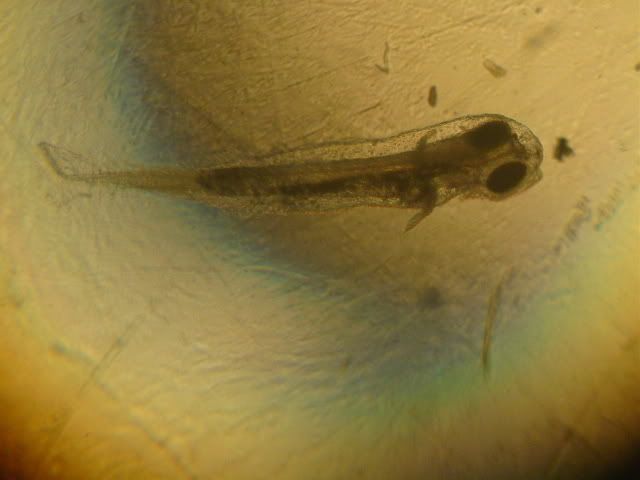 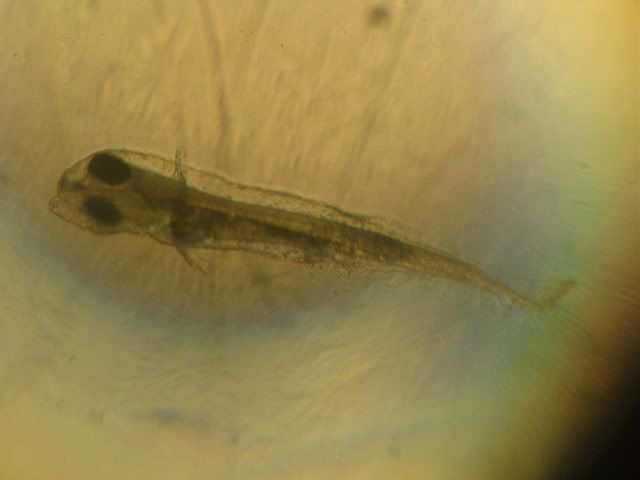
<message edited by luis a m on Friday, May 6, 2011 9:17 PM>
|
|
|
 Re:Incubating Centropyge eggs and prolarvae.
Saturday, May 7, 2011 8:02 AM
Re:Incubating Centropyge eggs and prolarvae.
Saturday, May 7, 2011 8:02 AM
( permalink)
Congratulations on getting them that far, Luis.
--Andy, the bucket man. "Not to know the mandolin is to argue oneself unknown...." --Clara Lanza, 1886
|
|
|
 Re:Incubating Centropyge eggs and prolarvae.
Saturday, May 7, 2011 1:13 PM
Re:Incubating Centropyge eggs and prolarvae.
Saturday, May 7, 2011 1:13 PM
( permalink)
Thanks  Two larvae survived to day 6.They now look like ordinary well developed larvae.I wonder why they could be that difficult to rear.Some reddish pigment can be seen on the back: 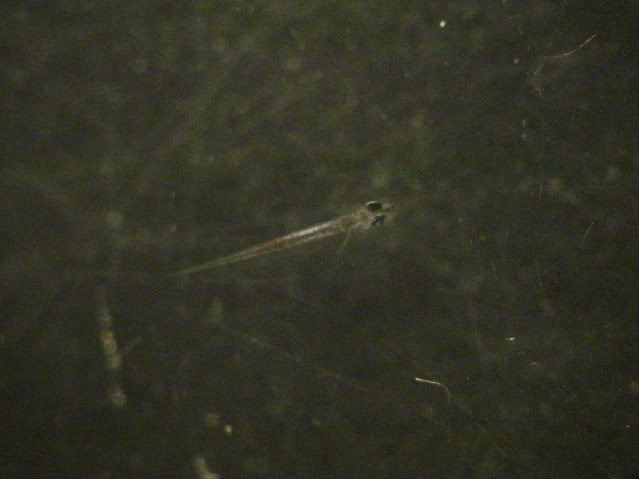 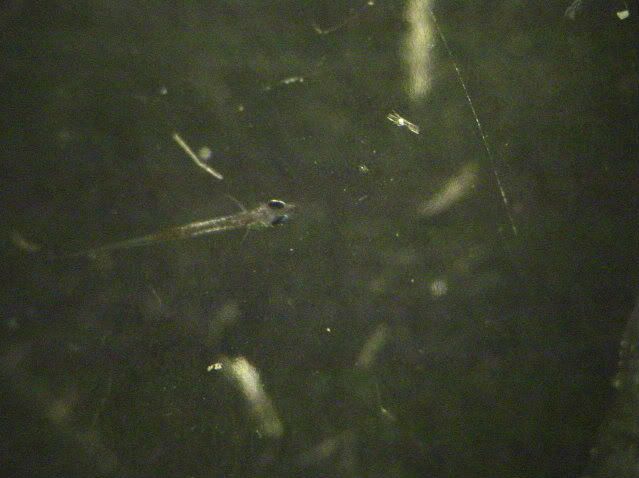 A view of the underside: 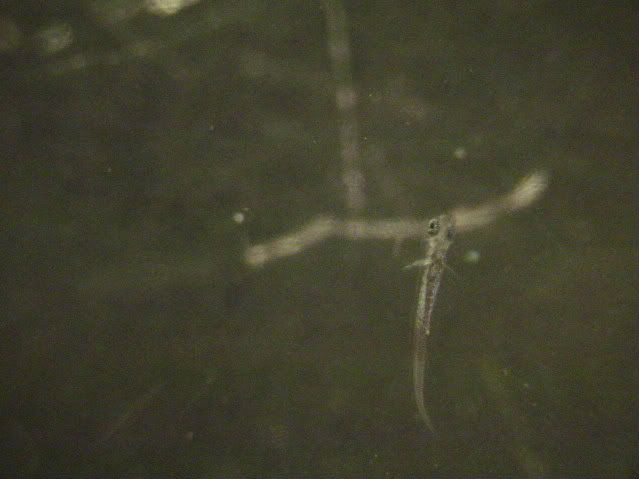 and a partial profile,showing the iridiscent scales on the flanks: 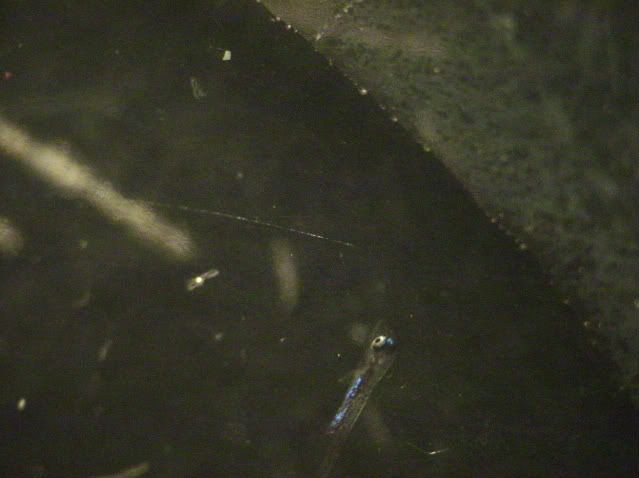
|
|
|
 Re:Incubating Centropyge eggs and prolarvae.
Saturday, May 7, 2011 2:21 PM
Re:Incubating Centropyge eggs and prolarvae.
Saturday, May 7, 2011 2:21 PM
( permalink)
Maybe it's just getting them to this point. Are they eating anything?
--Andy, the bucket man. "Not to know the mandolin is to argue oneself unknown...." --Clara Lanza, 1886
|
|
|
|